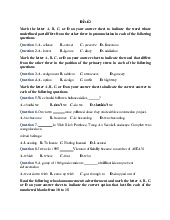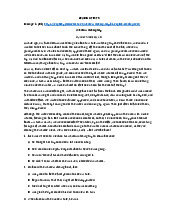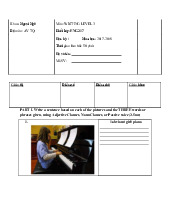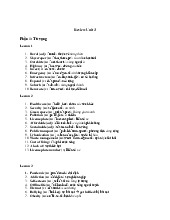




Preview text:
READING TEST 4 Passage 1: Sixteen - What now?
You’re 16 and finally you can leave school! By now, you’re probably sick of teachers, desks, tests and
exams. But don’t just run for the exit. You need to think carefully about what to do next.
If you want a professional career, you will need to go to university and get a degree(2). To do that, you
need to stay at high school for another two years. But you needn’t stay at the same place. There are
several options in the district of Northacre.
St. Leopold’s School has the best pass rate of all the high schools in the district(3). It offers a wide range
of subjects in the humanities and sciences. St Leopold’s is, of course, a private school, so may be too
expensive for you(4). But don’t worry, there are several other options if you want to follow the academic
route. Knowle Grammar School is a state school, so there are no fees, and it has excellent tuition and
facilities. It is a boys’ school from the ages of 11-16, but from 16-18 it is co-educational. But it is
selective, so you’ll have to pass an exam to get in.(5) If you’re interested in going into Business, check
out Wyle River Academy. This school specialises in subjects like Business Studies, Management and
Economics. If you prefer the arts, look at the courses on offer at Northacre College. Here you can study
woodwork, art, textiles and much more.
Northacre College also offers a wide range of vocational qualifications. You can do a 1-year certificate or
a 2-year diploma in subjects like electrics, plumbing, roofing and hairdressing. If you’d prefer to work
outdoors, look at Milldown College, where there are courses in Farm Mechanics, (6)Land Management,
Animal Management and much more.
A final option is to get an apprenticeship with a local or national company. You will get on-the-job
training, gain certificates or diplomas and start earning straight away. But be warned - places are limited!
Find out more at the Jobs Fair on 26th May at Northacre College. (10)
1 The aim of the article is to…
A. advise young people about how to get to university.
B. tell young people about the options available.
C. advise young people to stay in education.
2 The article advises reader who want a professional career to…
A. go to university immediately.
B. stay at the same school for two more years.
C. go to high school for two more years, then get a degree.
3 St Leopold’s is the best school for… A. good exam results. B. humanities and sciences. C. facilities.
4 You can only attend St Leopold’s school if you… A. pay tuition fees. B. pass an exam.
C. study both humanities and sciences.
5 You can only attend Knowle Grammar School if you… A. pass an exam. B. are a boy.
C. can afford the tuition fees.
6 Anna wants to work with horses. Where is the best place for her to study? A. Wyle River Academy B. Northacre College C. Milldown College
7 Harry wants to be a builder. Where is the best place for him to study?
A. Wyle River Academy B. Northacre College C. Milldown College
8 Kevin wants to be a fashion designer. Where is the best place for him to study?
A. Wyle River Academy B. Northacre College C. Milldown College
9 Caroline wants to run her own company. Where is the best place for him to study? A. Wyle River Academy B. Northacre College C. Milldown College
10 What is the problem with apprenticeships?
A. There are few available. B. They are expensive.
C. They don’t give you any qualifications. Passage 2:
O'Connell Street is the main thoroughfare and is one of the busiest shopping streets in Dublin. Even
though it is not a very long street, the locals will proudly tell the visitor that it is the widest street in
Europe. This claim often meets with protests, especially from French people, claiming the Champs
Elysees of Paris as Europe's widest street (12). But the witty (hóm hỉnh) Irishman won't easily relinquish
bragging rights and will trump the French visitor with a fine distinction(13): The Champs Elysees is an
avenue; O'Connell is a street. Divided by a few famous monuments running the length of its centre, the
street is named after Daniel O'Connell, an Irish patriot. His monument stands at the lower end of the road,
facing O'Connell Bridge (14). O'Connell stands high above the business people, unhurried crowds of
shoppers and students on a large column, surrounded by four angels representing Patriotism, Courage,
Eloquence, and Fidelity. Farther up the street on the other side is the famous General Post Office or the
GPO, as Dubliners call it. During the Easter Rising of 1916, the GPO was taken over by the Irish
Volunteers on Easter Monday and occupied by the revolutionary forces, sparking weeks of armed combat
in the heart of Dublin. To this day, three of the angels bear bullet holes - two with a wound in the chest and one in its left arm.
11) What is the writer's main purpose in writing the text?
A) to explain what it's like to be Irish
B) to describe historical sights on Dublin's O'Connell Street
C) to introduce readers to the biography of Daniel O'Connell
D) to show how difficult being a Dubliner can be
12) Dubliners claim that O'Connell Street ...
A) is the widest street in the world
B) is the widest street in Europe
C) is the longest street in all of Europe D) wider than it is long
13) What does the author say about the Irish people?
A) They are talkative and playful
B) They are rebellious and do not like foreigners
C) They never agree with French people
D) They are clever and funny
14) The Daniel O'Connell statue stands ...
A) opposite O'Connell Bridge
B) behind the General Post Office
C) at the upper end of the street
D) far away from the city centre
15) Which of the following would be the best title for this passage?
A) The Irish Take Pride in Their Capital City
B) The Widest Street in Europe
C) Sights and History on Dublin's O'Connell Street D) Dublin's Famous Landmark Passage 3:
1. In the 1880s, over three–fourths of Canada’s population lived outside urban centers. One view of rural
Canada at that time portrays it as a vast wasteland of isolated farm communities. However, a more
accurate view shows that rural Canadians had access to considerable information (16). The postal service
was efficient and inexpensive and connected rural Canadians with the outside world. Many farm families
received at least one newspaper through the mail, usually within a day of publication.(17) The daily
newspapers of the period were more substantial than those of today, and many reproduced precise
accounts of court trials and public events. Rural Canadians read magazines and books and held
discussions about them at club meetings.
2. Rural Canadians were also able to get together socially. The local school served other functions besides
providing formal education, and school districts were often the only sign of political organization in vast
regions of the country. Every community valued its one– room schoolhouse as a meeting place, especially
during the winter, when work on the farm was much lighter and people had more time for a variety of
social and cultural events (18). People of all ages got together to sing and play musical instruments,
perform skits, and play parlor games.
3. Between 1880 and 1920, there was a growing exodus from farms to the city, mainly because smaller
farms could not afford to modernize their technology and were no longer able to support the entire family.
(20) However, most Canadians continued to hold rural values, and artists and writers romanticized the
family farm. (21) In the novel Anne of Green Gables (1908), Lucy Maud Montgomery wrote about a
young woman who strove to reconcile the beauty and peace of the rural landscape with the need to leave it
in order to fulfill her ambitions. For large numbers of young Canadians, growing up meant leaving the
farm to find work in the city.(22)
16. According to the passage, rural Canada in the 1880s was not an isolated wasteland because
A. most farms were close to the city B. education was inexpensive
C. the rural population was growing
D. information was available to farmers
17. The author makes the point that the postal service
A. did not reach rural areas until the 1880s
B. served an important function in rural Canada
C. provided jobs for many rural Canadians
D. was expensive to operate in rural areas
18. Many social gatherings took place during the winter because
A. there was less work to do on the farm
B. there were fewer court trials or political activities
C. social gatherings were forbidden at other times
D. many holidays occurred in the winter
19. According to the passage, the rural school provided all of the following services EXCEPT A. formal education B. public health clinics C. political organization D. social and cultural events
20. What reason is given for large numbers of people leaving the family farm?
A. There was not enough work on the farm during the winter.
B. People grew tired of the social isolation of rural life.
C. Small farms could no longer support the whole family.
D. Modern farm technology was not available in many areas.
21. Which statement best describes the period from 1880 to 1920?
A. Literature portrayed a romanticized view of life on the farm.
B. More Canadians lived in urban areas than in rural areas.
C. Rural communities began to acquire characteristics of the city.
D. People gave up their rural values when they moved to the city.
22. The novel Anne of Green Gables serves to illustrate
A. the need for farmers to modernize their technology
B. the view of rural Canada as an isolated wasteland
C. the importance of social connections in rural Canada
D. the experience of many young Canadians of the period



